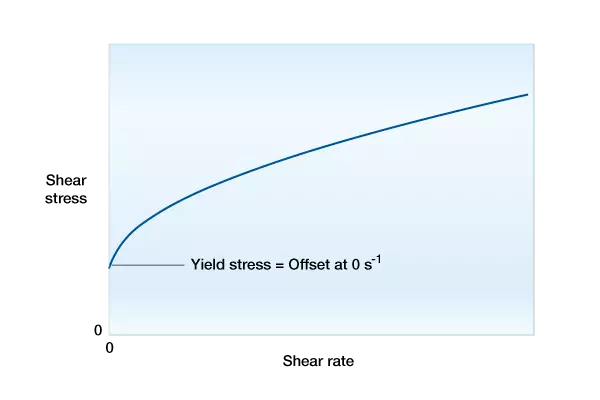Fluid Models
Fluids can be broadly classified as Newtonian or non-Newtonian. Water and light oil (such as diesel oil and mineral oil) are examples of Newtonian fluids, while whole drilling mud and cement slurry are examples of Non-Newtonian fluids.
Newtonian Fluids
A Newtonian fluid is one in which the shear stress is directly proportional to the shear rate. The slope of the line depicting that relationship is the viscosity of the fluid, and is a constant that does not depend on flow conditions, but only on temperature and pressure. Such behavior is termed “Newtonian” as it follows a relatively simple model of fluid behavior first derived by Isaac Newton (Figure 1).

A plot of friction pressure gradient versus flow rate for a Newtonian fluid (Figure 2) shows that such fluids begin to flow immediately when a pressure gradient is applied (i.e., the line goes through the origin). Provided that the flow is laminar, the relationship is linear, like the shear stress/shear rate relationship.
However, as the flow rate increases and the flow regime transitions to turbulent, the friction pressure increases faster than in laminar flow and the relationship is not linear – there is a slight upward curve to the line. When turbulent flow is achieved the linear relationship returns, but with a much faster increase in friction pressure with increased flow rate.

Non-Newtonian Fluids
Drilling mud and cement slurry do not behave according to the Newtonian model, and so are termed non-Newtonian fluids. Non-Newtonian fluids have two characteristics that distinguish them from the simpler Newtonian model:
- The curve on the shear stress-shear rate relationship does not pass through the origin. This means that a certain amount of stress (a yield stress) must be applied before the fluid starts to flow.
- The slope of the line changes with increasing shear rate. This means that the viscosity decreases with increased shear ratein what is called shear-thinning behavior.
Two models that have often been used to describe non-Newtonian behavior are the Bingham Plastic model and the Power Law model.
One example of a non-Newtonian model, which combines aspects of the Bingham Plastic and Power Law models, is the Herschel-Bulkley or Yield Power Law model (Figure 3) described by the following relationship:
![]()
Where ![]() is the yield stress, and K and m are empirically derived quantities known, respectively, as the Consistency Index the Power Law Index.
is the yield stress, and K and m are empirically derived quantities known, respectively, as the Consistency Index the Power Law Index.

As the flow rate increases and flow transitions from laminar to turbulent, the relationship changes and friction pressures increase much faster than predicted by the laminar flow relationship (Figure 4). All parts of the curve are nonlinear.

 Petro Shine The Place for Oil and Gas Professionals.
Petro Shine The Place for Oil and Gas Professionals.



